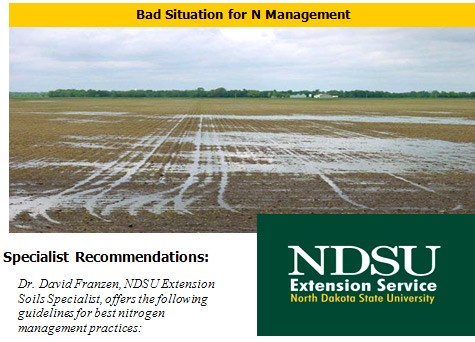558 - Nitrogen Management: What Works and Why
Nitrogen management for sugarbeets is a very challenging problem to get just right to maximize profit. Weather patterns have a great impact on soil temperature and moisture content. Soil temperature and moisture affect many nitrogen cycle processes including; mineralization, denitrification, volatilization, and leaching. Many growers have asked whether they should apply nitrogen for beets in the fall or spring. As is often the case in agriculture we return to the frustrating "It Depends" argument. Basically we're saying, tell me what the weather will be tomorrow, next week, next month or next year and we can give you that best management practice that work nearly all the time.

I have heard several growers exclaim that they will never Fall apply Nitrogen again. Although Fall-applied fields often suffered more loss than Spring-applied fields, it is not always the case. Growers that applied late in the Fall when our recommendations would suggest it was safer are more satisfied with their results than those that were early.
For those who cannot recall our NDSU recommendations for Fall nitrogen timing, here they are again.
- Do not Fall apply nitrogen on soils that typically flood in the spring, or to soils with sandy loam or coarser textures.
- Do not even think about applying anhydrous ammonia until October 1.
- After October 1, check the soil temperature measured at 4 inch depth from 6-8 a.m. When it hits 50° F, it is practical to apply anhydrous ammonia (but not urea!)
- A week after the date for anhydrous ammonia, growers can start applying banded urea.
- 2 weeks after the date for anhydrous ammonia, growers can start broadcast-incorporating urea.
This past season, the date the soil temperature dropped to 50° F was about October 15. That means that banded urea application should not have begun until October 22 and broadcast urea until October 29. I know that a great deal of Fall Nitrogen was applied before these dates. I know that I traveled to Bismarck for a meeting about September 20 and there was a grower applying anhydrous ammonia to a field near Jamestown. I also saw urea applicators in the field about the same time in the Valley. This was a very bad plan.
There is nothing wrong with well-timed Fall nitrogen application in North Dakota. In years of dry weather, it didn't matter when nitrogen was applied. If the last 18 years of wetness is an indication of the beginning of a trend, I think that this Winter and Spring will also be wet and we will be set up for losses for nitrogen that was applied too early. Agronomy does not always mesh with convenience. Although many growers have a "harvest gap" in September after small grain harvest and before soybeans/corn/sunflower, it is not the time to Fall apply nitrogen. P and K can be applied during this time, but not nitrogen. Too many bad things can happen to early applied nitrogen if it is applied too early with too much Fall ahead of it.
A nitrification inhibitor should be used not to move the date of application earlier, but to protect the N-applied at a safer date from unanticipated losses from early spring wetness. N-Serve™ can be applied with anhydrous ammonia to protect N from losses due to denitrification in the Fall/Spring. Instinct™ is an encapsulated form of nitrapyrin (active ingredient in N-Serve), and the label I have currently lists it as a spring additive with urea or UAN. Check with your Dow-Agro Sciences representative to see if it is labeled for Fall application with urea. In the Spring products with the additive DCD (examples are Super-U™ by Agrotain, Int., or Guardian™ by Conklin) will also slow nitrification. One product that is sold as a nitrification inhibitor, but does not function like one is Nutrisphere™. It is neither a nitrification inhibitor nor a urease inhibitor and should not be used as one.
Don't Forget Zone Nitrogen Management
Variable rate nitrogen management has consistently proven to increase grower revenue per acre year after year. Zone fertility management will also minimize the negative impact of adverse weather. Contact your fertilizer supplier, crop consultant or agriculturist for assistance with precision nitrogen management
Crop Rotation Concern
Sugarbeet yields can be significantly impacted by previous crop in the rotation. Small grains reduce Rhizoctonia risk, edible beans, corn and soybeans increase Rhizoctonia risk.
Drainage for Profit
Take advantage of completed small grain harvest to tackle needed drainage projects on your farm.
